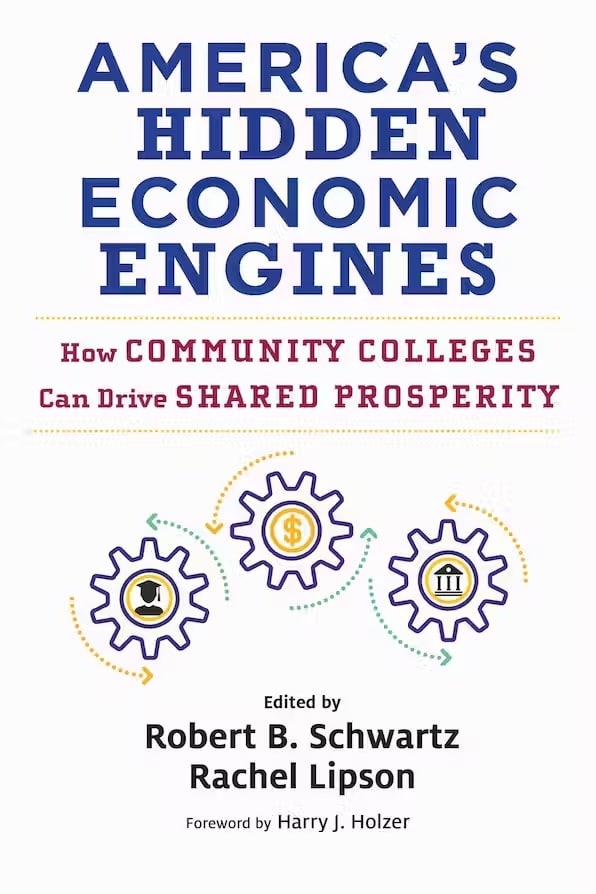In Plain Sight
Review of
America’s Hidden Economic Engines: How Community Colleges Can Drive Shared Prosperity
Cambridge, MA: Harvard Education Press, 2023, 224 pp.

Community colleges are the workhorses of American higher education. They are what this book refers to as “the ‘hidden engines’ that can drive shared prosperity.” Community colleges are tied tightly to their localities, engaging students in associate degrees, pre-baccalaureate courses, skills-based certificates, and noncredit classes. Those enrolled at community colleges are more likely than students at four-year schools to be first-generation college students or come from disadvantaged backgrounds. By design, community colleges are embedded in the economies of their communities and responsive to the needs of local firms.
America’s Hidden Economic Engines profiles five community colleges and the impact these institutions have on their local economies. Edited by Robert B. Schwartz and Rachel Lipson, this slim volume is the eighth installment in Harvard Education Press’s Work and Learning series. The cases are authored by graduate students and were written over three months, with each community college providing access to someone on the senior leadership team as a point of contact. The authors describe the cases they examine as exemplars, but I suspect they are a fairly representative sample of community colleges throughout the United States and the creative ways they have adapted to the needs of their communities amid decades of economic changes.
The first case study examines Lorain County Community College in Ohio, which has taken a thoughtful approach to matching students with career opportunities, highlighting the importance of jobs in manufacturing. However, the chapter credits this single institution as a driver of growth for northeastern Ohio, ignoring the other community colleges and institutions of higher education that pepper that landscape. This is not to take anything away from Lorain County Community College, but simply to point out that economic development is never attributable to a single organization or institutions—it always involves an ecosystem. Just as we now recognize that most successful innovations come from teams rather than lone geniuses, I don’t think it’s productive to look at single institutions without appreciating their context and role in the local economy.
The cases are each different, in that they represent a different focus and geography and client population. The other colleges the book examines include Mississippi Gulf Coast Community College, Northern Virginia Community College, Pima Community College in Arizona, and San Jacinto Community College in Texas. Disappointingly, the cases do not follow a similar template, making it difficult to compare them with one another. The editors make other questionable choices. For example, tables look at enrollment by race using absolute numbers rather than percentages, and the definitions of the community college service area are conflated from counties to full metropolitan areas.
Just as we now recognize that most successful innovations come from teams rather than lone geniuses, I don’t think it’s productive to look at single institutions without appreciating their context and role in the local economy.
Although well intentioned, the case study write-ups can reflect the elite orientation of the authors, who sometimes seem surprised by their discovery of these important institutions. Here the use of the term “hidden” in the book’s title is revealing. These important institutions are certainly not hidden from the 10 million students and the numerous educators who teach there. Local policymakers and employers who depend on community colleges are also aware of their potential. This book can be useful to raise awareness for policymakers who do not support or understand community colleges, but its identification of the cases as exceptional is problematic.
The comprehensive reference guide to community colleges in the United States is The American Community College by Carrie B. Kisker, Arthur M. Cohen, and Florence B. Brawer. The book’s seventh edition is the latest installment in a four-decade effort to provide information and statistics about community colleges. It provides a comprehensive understanding of the role community colleges play in the American educational system and economy, including their collaborations with community, economic, and workforce development organizations; recent efforts to improve student persistence and attainment through guided pathways and equity-minded student supports; and the growing emphasis on preparing a skilled workforce via noncredit training, credit for prior learning, microcredentials, and community college baccalaureate programs. This reference work demonstrates how essential community colleges are to American education in a way that’s difficult to grasp from a select few case studies.
Community colleges are important and often underappreciated institutions in the American economy and deserve more study and consideration. America’s Hidden Economic Engines will help draw attention to the role of community colleges and the way they operate. However, much more work needs to be done to better understand how to harness these remarkable economic engines, best engage with local companies, and provide reliable funding to increase opportunity for a full range of Americans.
